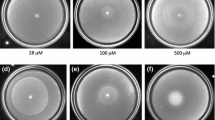Abstract
Motile bacteria have long been known to swim towards or away from specific environmental stimuli such as nutrients, oxygen or light. Although there has been a detailed description of chemosensory responses in enteric species for several years, there has been little information on the mechanisms involved in responses to stimuli affecting electron transport as these usually also change the electrochemical proton gradient – at least transiently – and, thus, directly change flagellar rotation. There have, however, been major advances recently. Halobacterium salinarium uses a retinal-based sensory system to sense changes in specific wavelengths of light and to signal via a transmembrane sensory protein, which turns out to be homologous to the transmembrane chemoreceptors of Escherichia coli. A FAD-binding protein, also related to these receptors, signals changes in respiratory electron transport in E. coli. Rhodobacter sphaeroides cells do not respond to light or oxygen specifically, but sense a change in the rate of electron transfer, probably again using an electron-transport-chain-linked redox sensor, signalling through a common sensory pathway. These recent studies reveal that bacteria not only sense a range of environmental stimuli but also integrate the signals through common pathways to produce a balanced flagellar response.
Similar content being viewed by others
Author information
Authors and Affiliations
Additional information
Received: 5 March 1997 / Accepted: 26 May 1997
Rights and permissions
About this article
Cite this article
Armitage, J. Behavioural responses of bacteria to light and oxygen. Arch Microbiol 168, 249–261 (1997). https://doi.org/10.1007/s002030050496
Issue Date:
DOI: https://doi.org/10.1007/s002030050496




